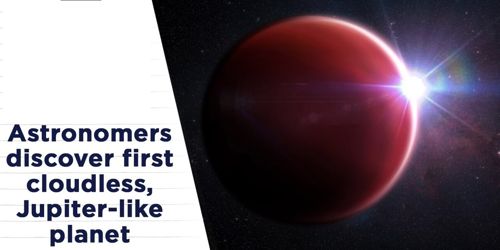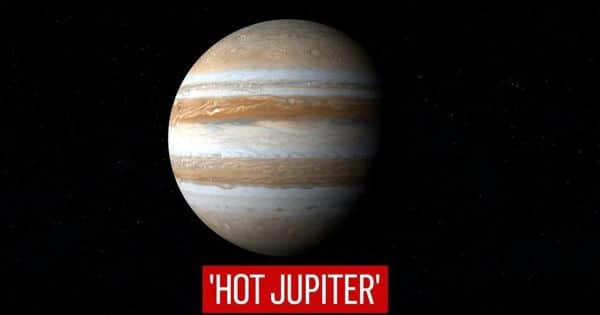Astronomers observed the first Jupiter-like planet with no dust or pollution in its visible atmosphere. This was the second time astronomers have ever seen cloud-free exoplanet astronomers at the Center for Astrophysics | Harvard & Smithsonian have observed the first cloud-free Jupiter-like planet in its detectable atmosphere.
A team of fifteen scientists led by Munazza Alam, NSF Graduate Research Associate, National Geographic Young Adventurer, and a third-year graduate student at the Department of Astronomy at Harvard University, used the Hubble Space Telescope to record data and observe the earth using spectroscopy.
Astronomers have discovered an exoplanet that has a clear atmosphere with no clouds, only the second-ever exoplanet like this discovered. It’s also the first-ever cloudless “hot Jupiter” discovered, giving astronomy an incredible opportunity to study these unusual worlds in more detail.
Called WASP-62b, the gas giant was first observed by the Wide Angle Search for Planets (WASP) South survey in 2012. WASP-62b is an exoplanet comparable in scale to the Jupiter Solar System, but very peculiar in that it has no clouds or haze in its atmosphere. Its climate, however, has never been closely observed so far.
“For my thesis, I have been working on exoplanet characterization,” says Munazza Alam, a graduate student at the Center for Astrophysics who led the analysis. “I take discovered planets and I follow up on them to characterize their atmospheres.”
WASP-62b, also known as hot Jupiter, is around half the mass of Jupiter in our solar system. But unlike Jupiter, which takes almost twelve years to rotate around the sun, WASP-62b completes a revolution around the star in four-and-a-half days. The proximity of the planet to the star makes it incredibly hot, which is why it is also known as the “hot Jupiter.”

Known as the “hot Jupiter,” WASP-62b is 575 light-years distant and almost half the mass of our solar system is Jupiter. However, unlike our Jupiter, which takes almost 12 years to orbit the sun, WASP-62b is only four-and-a-half days to complete a rotation around the star. This proximity to the star makes it incredibly hot, hence the name of “hot Jupiter.”
Using the Hubble Space Telescope, Alam recorded planet data and measurements using spectroscopy, studying electromagnetic radiation to help detect chemical elements. Alam precisely watched WASP-62b as it swept three times in front of its host star, producing visible light measurements that could detect the presence of sodium and potassium in the planet’s atmosphere.
“I’ll admit that at first, I wasn’t too excited about this planet,” Alam says. “But once I started to take a look at the data, I got excited.”
Although there was no evidence of potassium, the presence of sodium was remarkably evident. The team was able to see the absolute sodium absorption lines in their data or their total fingerprint. Clouds or haze in the atmosphere will mask the full sodium signature, says Alam, and astronomers may typically only create slight signs of its existence.
“This is smoking-gun evidence that we are seeing a clear atmosphere,” she says.
Cloud-free planets are highly rare; researchers predict that fewer than 7% of exoplanets have visible atmospheres, according to recent studies. For starters, the first and only other known exoplanet with a transparent atmosphere was discovered in 2018. Called WASP-96b, this is known as a hot Saturn.
Astronomers assume that researching exoplanets with cloudless atmospheres will lead to a deeper understanding of how they were created. Their scarcity “suggests something else is going on or they formed in a different way than most planets,” Alam says. Simple atmospheres also make it possible to research the chemical makeup of planets and can better determine what the earth is made of.
With the launch of the James Webb Space Telescope later this year, the team expects to provide new chances to research and appreciate WASP-62b better. The advanced technology of the telescope, such as higher resolution and greater accuracy, should allow them to investigate the atmosphere even more closely in order to locate more components, such as silicon.
The study showed no signs of potassium, but the existence of sodium was evident. The analysis indicates that complete sodium absorption lines were visible in their results. This was probably because the presence of sodium was not hidden by fog or smoke in the atmosphere. Munazza said that the strong visibility of sodium in the hot Jupiter also indicated that the planet has a clear atmosphere. Analysis has shown that cloud-free planets are exceedingly rare, and it is known that less than 7% of exoplanets have transparent atmospheres. There is only one planet that is known to have a clear atmosphere besides WASP-62b, and it was discovered in 2018. The planet is classified as a hot Saturn and is called WASP-96b.















